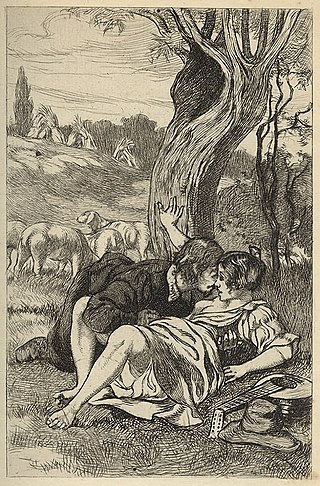
Attention is the concentration of awareness on some phenomenon to the exclusion of other stimuli. It is a process of selectively concentrating on a discrete aspect of information, whether considered subjective or objective. William James (1890) wrote that "Attention is the taking possession by the mind, in clear and vivid form, of one out of what seem several simultaneously possible objects or trains of thought. Focalization, concentration, of consciousness are of its essence." Attention has also been described as the allocation of limited cognitive processing resources. Attention is manifested by an attentional bottleneck, in terms of the amount of data the brain can process each second; for example, in human vision, only less than 1% of the visual input data can enter the bottleneck, leading to inattentional blindness.
Fatigue describes a state of tiredness or exhaustion. In general usage, fatigue often follows prolonged physical or mental activity. When fatigue occurs independently of physical or mental exertion, or does not resolve after rest or sleep, it may have other causes, such as a medical condition.

Wishful thinking is the formation of beliefs based on what might be pleasing to imagine, rather than on evidence, rationality, or reality. It is a product of resolving conflicts between belief and desire. Methodologies to examine wishful thinking are diverse. Various disciplines and schools of thought examine related mechanisms such as neural circuitry, human cognition and emotion, types of bias, procrastination, motivation, optimism, attention and environment. This concept has been examined as a fallacy. It is related to the concept of wishful seeing.
Habituation is a form of non-associative learning in which a non-reinforced response to a stimulus decreases after repeated or prolonged presentations of that stimulus. For example, organisms may habituate to repeated sudden loud noises when they learn these have no consequences.
Content theory is a subset of motivational theories that try to define what motivates people. Content theories of motivation often describe a system of needs that motivate peoples' actions. While process theories of motivation attempt to explain how and why our motivations affect our behaviors, content theories of motivation attempt to define what those motives or needs are. Content theory includes the work of David McClelland, Abraham Maslow and other psychologists.

Curiosity is a quality related to inquisitive thinking such as exploration, investigation, and learning, evident in humans and animals. Curiosity is associated with all aspects of human development, from which derives the process of learning and desire to acquire knowledge and skill.
Inattentional blindness or perceptual blindness occurs when an individual fails to perceive an unexpected stimulus in plain sight, purely as a result of a lack of attention rather than any vision defects or deficits. When it becomes impossible to attend to all the stimuli in a given situation, a temporary "blindness" effect can occur, as individuals fail to see unexpected but often salient objects or stimuli.
Self-control is an aspect of inhibitory control, one of the core executive functions. Executive functions are cognitive processes that are necessary for regulating one's behavior in order to achieve specific goals. Defined more independently, self-control is the ability to regulate one's emotions, thoughts, and behavior in the face of temptations and impulses. Thought to be like a muscle, acts of self control expend a limited resource. In the short term, overuse of self-control leads to the depletion of that resource. However, in the long term, the use of self-control can strengthen and improve the ability to control oneself over time.

Change blindness is a perceptual phenomenon that occurs when a change in a visual stimulus is introduced and the observer does not notice it. For example, observers often fail to notice major differences introduced into an image while it flickers off and on again. People's poor ability to detect changes has been argued to reflect fundamental limitations of human attention. Change blindness has become a highly researched topic and some have argued that it may have important practical implications in areas such as eyewitness testimony and distractions while driving.
Salience is that property by which some thing stands out. Salient events are an attentional mechanism by which organisms learn and survive; those organisms can focus their limited perceptual and cognitive resources on the pertinent subset of the sensory data available to them.
Attentional bias refers to how a person's perception is affected by selective factors in their attention. Attentional biases may explain an individual's failure to consider alternative possibilities when occupied with an existing train of thought. For example, cigarette smokers have been shown to possess an attentional bias for smoking-related cues around them, due to their brain's altered reward sensitivity. Attentional bias has also been associated with clinically relevant symptoms such as anxiety and depression.
Lawrence W. Barsalou is an American psychologist and a cognitive scientist, currently working at the University of Glasgow.
Emotional responsivity is the ability to acknowledge an affective stimuli by exhibiting emotion. It is a sharp change of emotion according to a person's emotional state. Increased emotional responsivity refers to demonstrating more response to a stimulus. Reduced emotional responsivity refers to demonstrating less response to a stimulus. Any response exhibited after exposure to the stimulus, whether it is appropriate or not, would be considered as an emotional response. Although emotional responsivity applies to nonclinical populations, it is more typically associated with individuals with schizophrenia and autism.
Attention restoration theory (ART) asserts that people can concentrate better after spending time in nature, or even looking at scenes of nature. Natural environments abound with "soft fascinations" which a person can reflect upon in "effortless attention", such as clouds moving across the sky, leaves rustling in a breeze or water bubbling over rocks in a stream. Philosophically, nature has long been seen as a source of peace and energy, yet the scientific community started rigorous testing only as recently as the 1990s which has allowed scientific and accurate comments to be made about if nature has a restorative attribute.

Exhibit design is the process of developing an exhibit—from a concept through to a physical, three-dimensional exhibition. It is a continually evolving field, drawing on innovative, creative, and practical solutions to the challenge of developing communicative environments that 'tell a story' in a three-dimensional space.
Somatic symptom disorder, also known as somatoform disorder, is defined by one or more chronic physical symptoms that coincide with excessive and maladaptive thoughts, emotions, and behaviors connected to those symptoms. The symptoms are not purposefully produced or feigned, and they may or may not coexist with a known medical ailment.

Sexual arousal describes the physiological and psychological responses in preparation for sexual intercourse or when exposed to sexual stimuli. A number of physiological responses occur in the body and mind as preparation for sexual intercourse, and continue during intercourse. Male arousal will lead to an erection, and in female arousal, the body's response is engorged sexual tissues such as nipples, vulva, clitoris, vaginal walls, and vaginal lubrication.
Emotion perception refers to the capacities and abilities of recognizing and identifying emotions in others, in addition to biological and physiological processes involved. Emotions are typically viewed as having three components: subjective experience, physical changes, and cognitive appraisal; emotion perception is the ability to make accurate decisions about another's subjective experience by interpreting their physical changes through sensory systems responsible for converting these observed changes into mental representations. The ability to perceive emotion is believed to be both innate and subject to environmental influence and is also a critical component in social interactions. How emotion is experienced and interpreted depends on how it is perceived. Likewise, how emotion is perceived is dependent on past experiences and interpretations. Emotion can be accurately perceived in humans. Emotions can be perceived visually, audibly, through smell and also through bodily sensations and this process is believed to be different from the perception of non-emotional material.
Cognitive inhibition refers to the mind's ability to tune out stimuli that are irrelevant to the task/process at hand or to the mind's current state. Additionally, it can be done either in whole or in part, intentionally or otherwise. Cognitive inhibition in particular can be observed in many instances throughout specific areas of cognitive science.
The Museum Experience is a non-fiction book written by John H. Falk and Lynn D. Dierking. It is considered by many in the museum profession to be amongst the most important books on museum learning.







